When I started telling people I was getting my wisdom teeth removed, it seemed like everyone had a story. Some people gave me good advice and helpful tips; others just told me their horror stories (presumably in the hopes that my experience couldn’t possibly be that bad). Probably 75% of everyone’s horror stories ended with, “And then I got dry socket,” which, of course, prompted me to do some Google research, which freaked me out even more.
It was bad enough that I only had a week to prepare — or, come to think of it, maybe that was a good thing. I’d made the appointment immediately after my drill-n-fill the previous Friday — one filling on each side, so my entire jaw was numb (for five hours). I had NOT expected the nice cashier to say, “We have some openings next Friday…”
I had so many questions, but barely managed to enunciate my most important one: “Will I need someone to drive me home?” The cashier had assured me that, no, I wouldn’t be sedated. The procedure would be done under local anesthetic, “just like today!”
Everyone has a wisdom tooth story; now I have one, too. And, as my mother would say, it’s a lot of words.
Pre-Op
First of all, why did I need my wisdom teeth removed in the first place? And why now, when I’m 34?
Here. Let me show you:
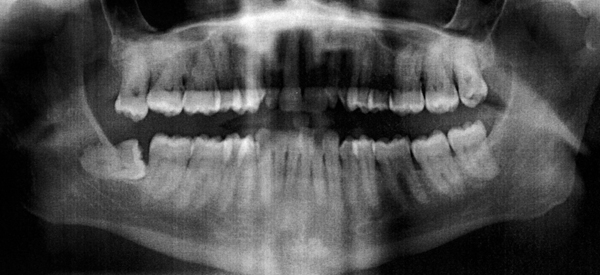
That bottom-right wisdom tooth (bottom-left on the x-ray) was coming in straight sideways. That part of my mouth was almost always inflamed and irritated. The tooth above it had also erupted farther than it should have, having nothing to butt up against to tell it to stop growing downward.
Way back when I was about 22 or 23, while I was still covered on my step-Gary’s insurance, my dentist at the time made mention of me getting some cavities filled and getting my wisdom teeth removed. Before we managed to schedule any of that, though, I got too old and needed to get my own damn insurance. (Which wouldn’t happen until I got married a few years later.)
Long story short, I finally got on the ball last year and restarted the long journey of getting my teeth and gums healthy. I’m still on three- or four-month cleaning intervals instead of the standard six months, but things are getting healthier. This extraction will definitely help with that.
The Extraction
If this were the Discovery Health Channel, I believe this would be the place where I’d say, “The following blog entry contains descriptions of actual surgical procedures. Reader discretion is advised.”
The experience of having my wisdom teeth extracted will stay with me for some time, I think. I knew going into it that a.) the actual extraction wouldn’t hurt, but b.) the oral surgeon would probably be doing some unusual and possibly disturbing things in my mouth, like sawing and pulling and yanking. I was correct, on both counts. What I hadn’t counted on was the disturbing nature of the sounds and sensations that made it through the anesthesia.
First off, the anesthesia part of the program went much faster than I’d expected. After the dental assistant took my paperwork (including, thankfully, an informational sheet about my post-op care), the oral surgeon came in and — after introducing himself, of course — swabbed the inside of my mouth with the topical numbing agent. After what seemed like only a minute or two, he and his assistant came back, and he injected me twice with that damnably long needle.
I just stared straight at the ceiling and tried not to move.
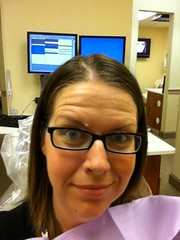 I wasn’t sure the assistant was talking about me when she said, “Wow! If everyone was as good a patient as her, our jobs would be a lot easier!” She went on to rave about how I hadn’t moved at all. “Everybody moves!” she went on. “Grown men move!” Since I was in the process of getting numb, I didn’t try to explain that I always try to keep perfectly still so that they won’t accidentally hurt me or stick me in the wrong place.
I wasn’t sure the assistant was talking about me when she said, “Wow! If everyone was as good a patient as her, our jobs would be a lot easier!” She went on to rave about how I hadn’t moved at all. “Everybody moves!” she went on. “Grown men move!” Since I was in the process of getting numb, I didn’t try to explain that I always try to keep perfectly still so that they won’t accidentally hurt me or stick me in the wrong place.
Barely had I managed to photograph my swelling cheek and send a “Yikes!” to Twitter when the oral surgeon came back and checked my numbness with a sharp instrument. The top was totally numb, but I could still feel just a smidge of pain on the bottom, so he stuck me with just a little more numbing juice.
And then we were ready to start.
Oh, shit.
I opened my mouth and closed my eyes. (And then I got a big surprise?)
Seriously, though, I didn’t want to see any of the instruments he’d be bringing near my mouth, especially after the stories I’d heard of dentists wrenching and sawing and manhandling other people’s teeth.
The top tooth was out in less than a minute. I think he walked me verbally through the procedure as he did it, but it might have just been the narrative in my head. I felt him clamp a tool around my tooth, heard/felt the most exquisite crunching sound as he levered the tooth out — and then it was over.
Actually, no. It wasn’t. We still had the bottom one to go.
Again, I kept my eyes shut as the oral surgeon did what he had to do to remove my sideways tooth. I could tell that it involved some sort of power tool — a drill, maybe, or a tiny saw. I’d like to imagine it was some sort of dental Dremel tool. At any rate, I sat through long minutes of buzzing, tugging, tapping, pulling, and yanking, until my jaw muscles were sore from keeping up a decent resistance against the forces at work in my mouth. When I once again felt that weird sensation of the roots being levered from my jaw, I was more relieved than weirded out.
All that was left to do was for the oral surgeon to stitch me up (which is a bizarre sensation unto itself) and for the assistant to take an x-ray of my mouth — free of charge, she explained, to ensure that they hadn’t missed anything. I got my prescriptions and some complimentary gauze, requested copies of my x-rays (just because), confirmed that I was paid in full, then headed to Walgreen’s to pick up my Vicodin (painkiller) and Amoxicillin (antibiotic). Then home.

Post-Op
My instructions stated that I was to change out the gauze in my mouth every 35-45 minutes or so, which I did. The amount of blood coming out of my mouth was alarming to me, and I did the best I could to a.) avoid freaking out, and b.) hide the bloody gauze in the bathroom trash so as not to gross out myself or Aaron. I was ever so gentle with my mouth, because I didn’t want to dislodge the clots that were forming. Dry socket is a bitch, or so I’d heard. I didn’t want to find out.
The numbness from the anesthetic wore off a lot quicker for the wisdom teeth than for the previous week’s fillings, which was both a good thing and a bad thing. Good because I was able to speak and enunciate (as well as I could with gauze in my mouth, anyway); bad because, well, I was in pain.
At some point, a few gauze-changes into the afternoon, I popped a Vicodin and managed to position myself and my ice pack in a nappable sitting position on the couch. That was the most welcome hour-long nap I’d taken in quite some time.
After I woke up from my nap, my body informed me that I *had* to eat SOMETHING. I was dizzy and disoriented — not only from taking Vicodin, but from taking it on an empty stomach — and the grumbles from my midsection were becoming ever more insistent.
So, once I saw Aaron off to work, I prepared for dinner by performing my first post-op salt water rinse. Which, let me tell you, was not only uncomfortable, but HELLA gross. Since I was explicitly told not to spit, but to just let the rinse fall out of my mouth, that’s exactly what I did. Watching that much bloody saltwater come drooling from my mouth is something I hope I never again have to experience.
Once my mouth was clean for the first time since the extraction, I ate a bowl of tomato soup. After that, I did feel much better.
The rest of the evening is kind of a blur, ending with me falling asleep on the recliner in a haze of Vicodin and exhaustion, with the Food Network blaring Guy Fieri in the background. Eventually, around 1:00am, I relocated to the bedroom and was out like a pinched wick.
Recovery
I woke up on Saturday feeling surprisingly fine. The pain was down to a Tylenol level, rather than a Vicodin level, so I didn’t spend the day drugged-up on the couch and watching movies like I had expected. Instead, Aaron and I went out to lunch (lentil soup for me), where we happened upon some friends; then out to one of the outdoor malls to enjoy the weather, where we happened upon some more friends. Dinner also involved careful eating: Panera’s creamy tomato soup in a bread bowl. Sunday’s traditional dim sum lunch was (for me, anyway) pared down to turnip cakes supplemented by a bowl of egg drop soup, and Sunday dinner at home was acorn squash with even more tomato soup.
Monday, I was back to work, armed with pudding and Jell-O and yogurt and a bottle of Tylenol.
This week has been a slow but steady recovery, gradually getting away from the Vicodin (which I’m VERY glad I had for the first day and the first few evenings) and getting back into firmer foods. Now, one week after the extraction, my jaw muscles are still sore, but the sockets themselves don’t really hurt much. I haven’t even had to take Tylenol since probably Wednesday. I’m still weirded out by having space in my mouth where there hasn’t been space for ten years, but I’ll get used to that.
By some combination of Dr. Hashemi’s skill and my extreme caution during recovery, I haven’t developed dry socket or any other complications. Soon I’ll be back to normal entirely: not having to be so careful while brushing my teeth, being able to open my mouth all the way again, being able to eat chewy and crunchy foods without worry or pain.
I suppose this will pave the way to me getting braces eventually, now that there’s some extra room in my mouth…
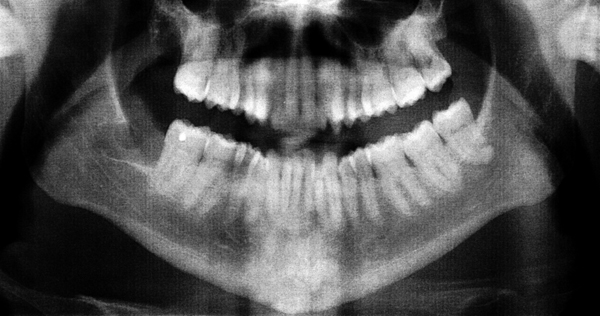
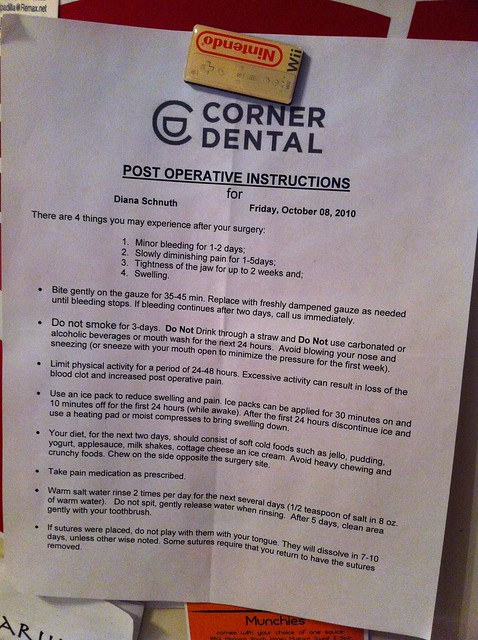
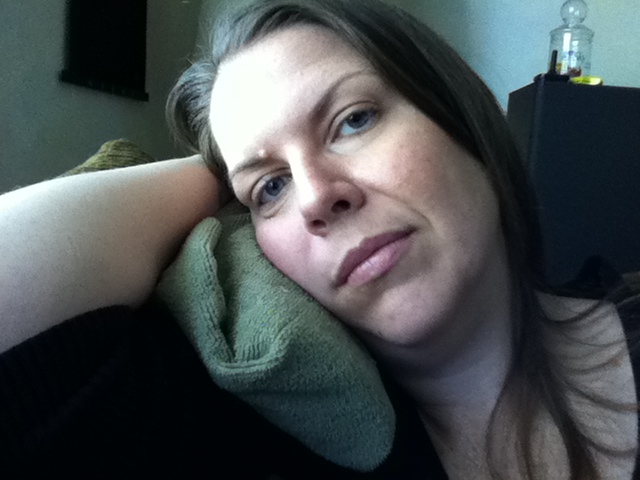
Hooray for Vicodin and tomato soup! 🙂
My mom said she can’t post a comment here, so this is a test post. Testes, testes…